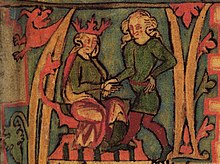Harald Fairhair
Harald Fairhair (c. 850 – c. 932) was the first King of Norway. According to traditions today in Norway and Iceland, during the 12th and 13th centuries, he was king from 872 to 930. Most of what we know about him comes from several sagas, written up to three centuries after he died.[a][1]
| Harald Fairhair | |||||
|---|---|---|---|---|---|
 Harald Fairhair, in an illustration from the 14th century Flateyjarbók. | |||||
| King of Norway | |||||
| Reign | 872–930 | ||||
| Successor | Eric I | ||||
| Born | c. 850 | ||||
| Died | c. 932 Rogaland, Norway | ||||
| Burial | |||||
| Spouse | Ragnhild Eriksdotter Åsa Håkonsdotter | ||||
| Issue more | Eric I of Norway Haakon I of Norway | ||||
| |||||
| Dynasty | Fairhair dynasty | ||||
| Father | Halfdan the Black | ||||
| Mother | Ragnhild (Haraldsdotter or Sigurdsdotter?) | ||||
| Religion | Norse religion | ||||
Life
changeHe was the son of Halvdan the Black.[2] Harald was the first petty king to gain control of the coastal areas of Norway.[2] After the battle of Hafrsfjord in 872 Harald became king of most of Norway.[3] It was the last of a series of battles between Harald and other feudal states in Norway.[2]
Because of Skaldic poems (poems honouring heroes in Scandinavia), we know that he was successful in fighting against his opponents in Norway. Eric Bloodaxe and Haakon the Good, his two sons, became King after he died of old age.
Fairhair may have had as many as 11-20 sons according to different Sagas. Twelve of them became Kings[b] and were all assigned land.
Notes
change- ↑ The "Tale of Harald Fairhair" dates from about 1230 or later.[1] It is based on the Heimskringla and an older "Harald Fairhair" saga that is now lost.[1] The "Tale of Halfdan the Black" also draws on now-lost sagas of earlier dates.[1] The "Saga of Olaf Tryggvason" was not compiled until the 14th century. It is based on an earlier version written down by monks about 1180–90. It also contains information from the Hiemskringla.[1]
- ↑ The number twelve may suggest a biblical influence by later authors.[4] These numbers can and do occur in oral histories but they can also show a later influence.[4] Iceland had converted to Christianity by the end of the 10th century.[5] Most of the later sagas were written in Iceland.[6]
References
change- ↑ 1.0 1.1 1.2 1.3 1.4 Bruce Lincoln, Between History and Myth: Stories of Harald Fairhair and the Founding of the State (Chicago; London: The University of Chicago Press, 2014), p. 9
- ↑ 2.0 2.1 2.2 Historia Norwegie, eds. Inger Ekrem, Lars Boje Mortensen (København Museum Tusculanum Press, 2003), p. 81
- ↑ Gerhard Lemmer; Elke Frey; Helga Rahe, Norway (Munich; Nelles; Basingstoke: GeoCenter, 2001), p. 16
- ↑ 4.0 4.1 John Van Seters, In Search of History: Historiography in the Ancient World and the Origins of (Winona Lake, IN: Eisenbrauns, 1997), p. 50
- ↑ Jacques Le Goff, The Birth of Europe (Oxford: John Wiley & Sons, 2005), p. 43
- ↑ Phil Lee, The Rough Guide to Norway (London: Rough Guides, 2003), p. 377
More reading
change- Viking Empires by Angelo Forte, Richard Oram and Frederik Pedersen (Cambridge University Press. June 2005)
- The Oxford Illustrated History of the Vikings Peter Sawyer, Editor (Oxford University Press, September 2001)
- Jakobsson, Sverrir, "Erindringen om en mægtig personlighed : den norsk-islandske historiske tradisjon om Harald Hårfagre i et kildekristisk perspektiv]," Historisk tidsskrift, 81 (2002), 213–30.
- Raffensperger, Christian, "Shared (Hi)Stories: Vladimir of Rus' and Harald Fairhair of Norway," The Russian Review, 68,4 (2009), 569-582.